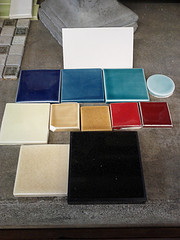Porcelain vs Ceramic Tile -- Which Is for You?
 Do you think that porcelain and ceramic tile are essentially the same? You may be surprised to find that, though both are manufactured of similar ingredients using similar processes, there are some important differences. Familiarize yourself with the characteristics of both these tile types so you can choose the kind that offers the right price, durability, and good looks for your tiling project.
Do you think that porcelain and ceramic tile are essentially the same? You may be surprised to find that, though both are manufactured of similar ingredients using similar processes, there are some important differences. Familiarize yourself with the characteristics of both these tile types so you can choose the kind that offers the right price, durability, and good looks for your tiling project.
What is the difference?
The difference is in the details. Ceramic tile is manufactured from red or white clay mixed with water and minerals, then baked in a type of kiln. It is nearly always finished with a glaze to reduce its natural porosity.
Porcelain tile is made from light-colored clays with a fine grain (this gives it a dense body), quartz, feldspar, and a minimal amount of water, is pressed or extruded before being fired at substantially higher temperatures than regular ceramic. It is sold in both glazed and unglazed versions. The Porcelain Tile Certification Agency (PTCA) will certify tile as true porcelain only if it passes their rigorous testing.
Advantages of Porcelain Tile
+ Beauty
+ Long life
+ Crack and stain resistance
+ Durability -- perfect for any use, from decorative wall tiles to rugged heavy-traffic flooring
+ High Porcelain Enamel Institute (PEI) ratings for hardness and durability
+ Low water absorption (less than 0.5 percent)
+ Usability for outdoor features
+ Frost resistance
+ Superior strength that allows it to be formed into a huge range of sizes
+ Ability to be rectified -- that is, cut precisely to size so that all tiles are uniform and grout lines are minimized
Disadvantages of Porcelain Tile
- Cost of porcelain tile
- Necessity to hire a tile professional for installation due to its brittleness, which requires special tools and cutting methods
- Heavy weight, making it more difficult to transport
- Sealing required for polished porcelain tile
Advantages of Ceramic Tile
+ Cost of ceramic tile, which is considerably less expensive than porcelain tile
+ Easy cutting and installation
+ Light weight
Disadvantages of Ceramic Tile
- More limited number of styles
- Higher porosity, making it more moisture-permeable
- Susceptibility to cracking and staining
- Unsuitability for use outdoors in high-frost regions or as flooring in heavy foot traffic areas
- Lower PEI ratings
Suitability of Porcelain vs Ceramic Tile for Common Uses
| USE | PORCELAIN TILE | CERAMIC TILE | |
Bathtub exterior | Yes (moisture resistant) | Not recommended | |
Ceiling | Yes | Yes | |
Fireplace surround | Yes | Yes, if the tile was high fired | |
Floor (indoor) | Yes, for all traffic levels | May be unsuited for high traffic | |
Floor (indoor, radiant heated) | Yes | Yes | |
Floor (outdoor, unheated garage) | Yes (durable, frost resistant) | Not recommended | |
Garden path | Yes (durable, frost resistant) | Not recommended | |
Home spa | Yes (moisture resistant) | Not recommended | |
Kitchen or bathroom counter | Yes (high gloss will scratch easily) | Yes (high gloss will scratch easily) | |
Patio, balcony, or deck | Yes (durable, frost resistant) | Not recommended | |
Pool surround | Yes (durable, frost resistant) | Not recommended | |
Shower stall | Yes (moisture resistant) | Not recommended | |
Sink backsplash | Yes | Yes | |
Vanity | Yes (moisture resistant) | Not recommended | |
Wall (living room, bedroom, entry) | Yes | Yes |
Laura Firszt writes for networx.com.
Updated July 24, 2018.
Looking for a Pro? Call us (866) 441-6648

Tile Contractors Experiences

Shower Tile Rehab In Hotel Guest Rooms

Tub And Shower Tile Upgrade To Replace Cheap Imitation Marble



